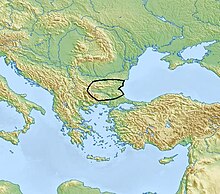Ezero culture
 | |
| Geographical range | Bulgaria |
|---|---|
| Period | Bronze Age Europe |
| Dates | c. 3300 – 2700 BC |
| Preceded by | Suvorovo culture, Karanovo culture, Gumelniţa culture, Varna culture, Cernavodă culture |
| Followed by | Myceneans, Trojans, Thracians |
| Bronze Age |
|---|
| ↑ Chalcolithic |
| ↓ Iron Age |
The Ezero culture, 3300—2700 BC, was a Bronze Age archaeological culture occupying most of present-day Bulgaria. It takes its name from the Tell-settlement of Ezero.
Ezero follows the copper age cultures of the area (Karanovo VI culture, Gumelniţa culture, Kodzadjemen culture, and Varna culture), after a settlement hiatus in Northern Bulgaria. It bears some relationship to the earlier Cernavodă III culture to the north. Some settlements were fortified.
The Ezero culture is interpreted as part of a larger Balkan-Danubian early Bronze Age complex, a horizon reaching from Troy Id-IIc into Central Europe, encompassing the Baden of the Carpathian Basin and the Coţofeni culture of Romania. According to Hermann Parzinger, there are also typological connections to Poliochne IIa-b and Sitagroi IV.
Economy
[edit]Agriculture is in evidence, along with domestic livestock. There is evidence of grape cultivation.[citation needed] Metallurgy was practiced.[citation needed]
Interpretation
[edit]Within the context of the Kurgan hypothesis, it would represent a fusion of native "Old European culture" and intrusive "Kurgan culture" elements. It could also represent an Anatolian-influenced culture, either coming from Anatolia (in Renfrew's hypothesis), or heading to Asia Minor.
Genetics
[edit]Haplogroups
[edit]Genetic studies have shown that the Ezero culture had a male haplogroup R1b. Among the female haplogroups were J2a1, T, U5a1, T2d2, W.[1]
Autosomal DNA
[edit]Genetically the Ezero culture was of local Neolithic origin mainly, also had a contribution from WSH, but this contribution was of varying degrees in the Ezero samples.[2]


Notes
[edit]- ^ Lazaridis, Iosif; Alpaslan-Roodenberg, Songül; Acar, Ayşe; Açıkkol, Ayşen; Agelarakis, Anagnostis; Aghikyan, Levon; Akyüz, Uğur; Andreeva, Desislava; Andrijašević, Gojko; Antonović, Dragana; Armit, Ian; Atmaca, Alper; Avetisyan, Pavel; Aytek, Ahmet İhsan; Bacvarov, Krum (2022). "The genetic history of the Southern Arc: A bridge between West Asia and Europe". Science. 377 (6609): eabm4247. doi:10.1126/science.abm4247. ISSN 0036-8075. PMC 10064553. PMID 36007055. S2CID 251843620.
- ^ Lazaridis, Iosif; Alpaslan-Roodenberg, Songül; Acar, Ayşe; Açıkkol, Ayşen; Agelarakis, Anagnostis; Aghikyan, Levon; Akyüz, Uğur; Andreeva, Desislava; Andrijašević, Gojko; Antonović, Dragana; Armit, Ian; Atmaca, Alper; Avetisyan, Pavel; Aytek, Ahmet İhsan; Bacvarov, Krum (2022). "The genetic history of the Southern Arc: A bridge between West Asia and Europe". Science. 377 (6609): eabm4247. doi:10.1126/science.abm4247. ISSN 0036-8075. PMC 10064553. PMID 36007055. S2CID 251843620.
Sources
[edit]- G.Il. Georgiev et al. (eds.), Ezero, rannobronzovoto selishte. Sofii︠a︡ : Izd-vo na Bŭlgarskata akademii︠a︡ na naukite, Arkheologicheski institut 1979 (excavation report of Tell Ezero).
- Mallory, J. P.; Adams, Douglas Q. (1997). "Ezero culture". Encyclopedia of Indo-European Culture. Taylor & Francis. p. 188. ISBN 1884964982.
